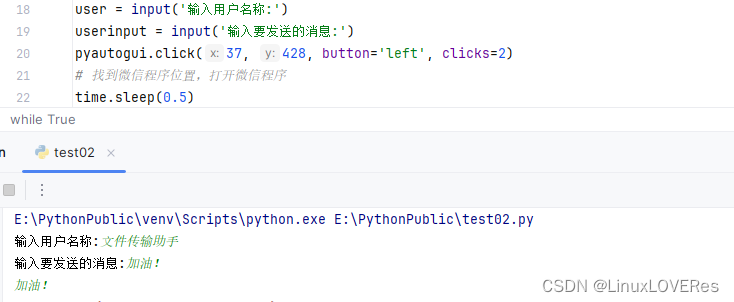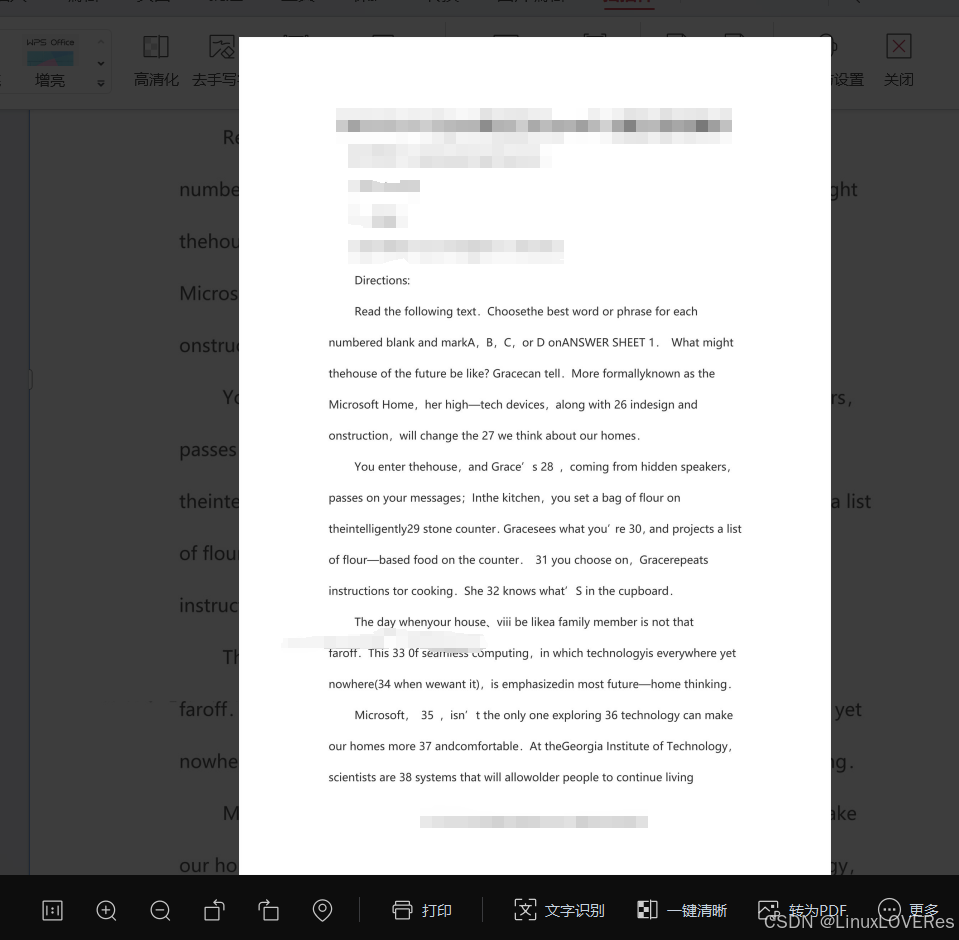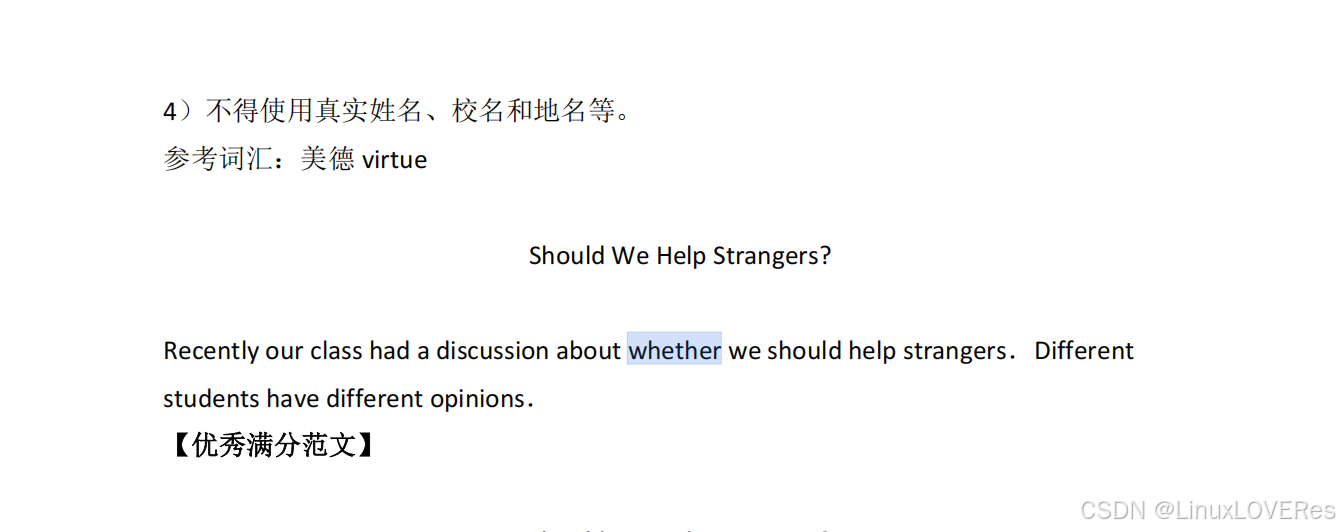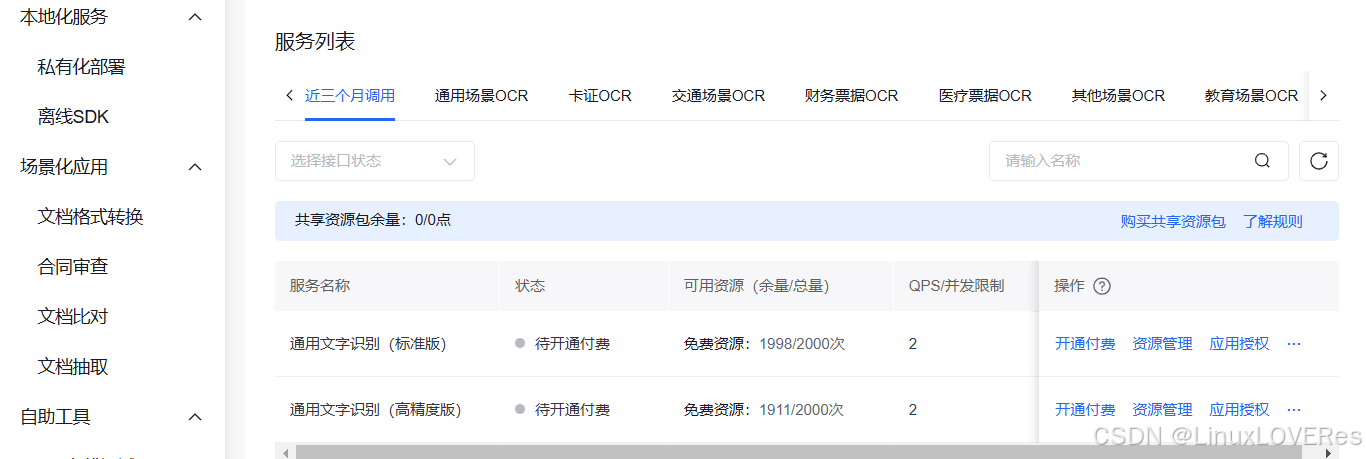一、制作基于windows系统批量重命名文件小工具
参考博客:
使用python做一个批量重命名文件的小工具_讷言丶的博客-优快云博客
效果展示:
临时01
代码实现:
import os
from tkinter import filedialog
import tkinter as tk
from tkinter import messagebox
root = tk.Tk()
root.geometry('400x200+550+200')
root.title('批量重命名文件小工具')
page = tk.Frame()
page.pack()
text = tk.StringVar()
def rename_file():
filepath = filedialog.askdirectory()
index = 0
if len(os.listdir(filepath)) == 0:
messagebox.showinfo(title="文件重命名", message="该目录下文件为空,请重新选择目录")
else:
for filename in os.listdir(filepath):
index += 1
file_path = os.path.join(filepath, filename)
if os.path.isfile(file_path):
name, ext = os.path.splitext(filename)
new_name = text.get() + str(index) + ext
# print(new_name)
os.rename(file_path, os.path.join(filepath, new_name))
messagebox.showinfo(title='文件重命名', message='文件重命名成功,请查看目录')
tk.Label(page).grid(row=0, column=1)
tk.Label(page, text='文件名称前缀:', font=('华文楷体', 15)).grid(row=2, column=1, pady=10)
tk.Entry(page, textvariable=text).grid(row=2, column=2)
tk.Button(page, text='选择目录并重命名文件', font=('华文楷体', 15), command=rename_file).grid(row=3, column=2)
root.mainloop()
二、制作时间戳转换器
效果展示:
临时03
代码实现:
import time
import tkinter as tk
from tkinter import messagebox
root = tk.Tk()
root.geometry('400x300+500+300')
root.title('时间戳转换工具')
usertime = tk.StringVar()
usertimestamp = tk.StringVar()
page = tk.Frame(root)
page.pack()
tk.Label(page).grid(row=0, column=1)
tk.Label(page, text='请输入时间【格式:Y-M-D h:m:s】:', font=('黑体', 10)).grid(row=1, column=1, pady=10)
tk.Entry(page, textvariable=usertime).grid(row=1, column=2)
tk.Label(page, text='请输入时间戳: ', font=('黑体', 10)).grid(row=3, column=1, pady=30)
tk.Entry(page, textvariable=usertimestamp).grid(row=3, column=2)
# 将时间转换为时间戳,秒级
def timestamp_s():
time_value = usertime.get()
timeArray = time.strptime(time_value, "%Y-%m-%d %H:%M:%S")
timestamp = time.mktime(timeArray)
times = int(timestamp)
messagebox.showinfo(title='时间戳(s)', message=f'获取到的时间戳(s)为{times}')
# 将时间转换为时间戳,毫秒级
def timestamp_ms():
time_value = usertime.get()
timeArray = time.strptime(time_value, "%Y-%m-%d %H:%M:%S")
timestamp = time.mktime(timeArray)
times = int(round(timestamp * 1000))
messagebox.showinfo(title='时间戳(s)', message=f'获取到的时间戳(s)为{times}')
# 秒级时间戳转换
def time_s():
time_value = usertimestamp.get()
if len(time_value) == 10:
timeas = int(time_value)
time_local = time.localtime(timeas)
dt = time.strftime("%Y-%m-%d %H:%M:%S", time_local)
messagebox.showinfo(title='时间', message=f'获取到的时间为{dt}')
elif len(time_value) == 13:
timeas = int(time_value)
timestamps = int(round(timeas / 1000))
time_local = time.localtime(timestamps)
dt = time.strftime("%Y-%m-%d %H:%M:%S", time_local)
messagebox.showinfo(title='时间', message=f'获取到的时间为{dt}')
tk.Button(page, text='转换为时间戳(s)', command=timestamp_s).grid(row=2, column=1)
tk.Button(page, text='转换为时间戳(ms)', command=timestamp_ms).grid(row=2, column=2)
tk.Button(page, text='转换为时间', command=time_s).grid(row=4, column=1)
root.mainloop()
三、制作图书管理小工具
效果展示:
临时02
代码实现:
import tkinter as tk
from tkinter import messagebox
# 定义Book类
class Book:
def __init__(self, title, author, isbn):
self.title = title
self.author = author
self.isbn = isbn
# 定义GUI窗口
class BookManagementSystem:
def __init__(self, master):
self.master = master
self.master.title("图书管理系统")
# 创建标题标签
tk.Label(self.master, text="图书管理系统", font=("Arial", 20)).grid(column=0, row=0, columnspan=3, pady=10)
# 创建书籍信息输入框
tk.Label(self.master, text="书名").grid(column=0, row=1)
self.title_entry = tk.Entry(self.master)
self.title_entry.grid(column=1, row=1, padx=5, pady=5)
tk.Label(self.master, text="作者").grid(column=0, row=2)
self.author_entry = tk.Entry(self.master)
self.author_entry.grid(column=1, row=2, padx=5, pady=5)
tk.Label(self.master, text="ISBN号").grid(column=0, row=3)
self.isbn_entry = tk.Entry(self.master)
self.isbn_entry.grid(column=1, row=3, padx=5, pady=5)
# 创建添加书籍按钮
self.add_book_button = tk.Button(self.master, text="添加书籍", command=self.add_book)
self.add_book_button.grid(column=0, row=4, pady=10)
# 创建书籍列表框
tk.Label(self.master, text="当前书籍列表").grid(column=2, row=1)
self.book_listbox = tk.Listbox(self.master)
self.book_listbox.grid(column=2, row=2, rowspan=3, padx=10, pady=5)
self.update_book_list()
# 创建删除书籍按钮
self.delete_book_button = tk.Button(self.master, text="删除书籍", command=self.delete_book)
self.delete_book_button.grid(column=2, row=4, pady=10)
# 添加书籍方法
def add_book(self):
title = self.title_entry.get()
author = self.author_entry.get()
isbn = self.isbn_entry.get()
book = Book(title, author, isbn)
with open("books.txt", "a") as f:
f.write(f"{book.title},{book.author},{book.isbn}\n")
messagebox.showinfo("添加书籍", "添加书籍成功!")
self.update_book_list()
# 删除书籍方法
def delete_book(self):
selection = self.book_listbox.curselection()
if len(selection) == 0:
messagebox.showerror("删除书籍", "请选择要删除的书籍!")
return
index = selection[0]
book = self.book_listbox.get(index)
with open("books.txt", "r") as f:
lines = f.readlines()
with open("books.txt", "w") as f:
for line in lines:
if line.strip() != book:
f.write(line)
messagebox.showinfo("删除书籍", "删除书籍成功!")
self.update_book_list()
# 更新书籍列表方法
def update_book_list(self):
self.book_listbox.delete(0, tk.END)
with open("books.txt", "r") as f:
for line in f.readlines():
book = line.strip()
self.book_listbox.insert(tk.END, book)
# 启动GUI窗口
if __name__ == '__main__':
root = tk.Tk()
app = BookManagementSystem(root)
root.mainloop()
四、制作jpg、png图片转ico图标小工具
效果展示:
临时04
代码实现:
import tkinter as tk
from tkinter import filedialog
# PythonMargick包可以到Unofficial Windows Binaries for Python Extension Packages下载
import PythonMagick
root = tk.Tk()
root.withdraw()
Fpath = filedialog.askopenfilename()
img = PythonMagick.Image(Fpath)
# 这里要设置一下尺寸,不然会报ico尺寸异常错误
img.sample('256x256')
img.write('robin.ico')五、制作图片和base64互转小工具
效果展示:
临时05
代码实现:
import base64
import tkinter as tk
from tkinter import filedialog
root = tk.Tk()
root.withdraw()
Fpath = filedialog.askopenfilename()
def file_to_base64():
print(Fpath)
f=open(Fpath,'rb') #二进制方式打开图文件
ls_f=base64.b64encode(f.read()) #读取文件内容,转换为base64编码
open('x.txt', 'wb').write(ls_f)
def base64_to_file():
print(Fpath)
decoded = base64.b64decode(open(Fpath, 'rb').read())
open('1.jpg', 'wb').write(decoded) # 保存
if __name__ == '__main__':
if "jpg" in Fpath or 'png' in Fpath or 'jpeg' in Fpath:
file_to_base64()
elif 'txt' in Fpath:
base64_to_file()六、制作英文翻译器(小工具)
代码逻辑:
requests模块请求第三方翻译接口,拿到数据后通过tkinter展示出来
效果展示:
临时06
代码实现:
import requests
import tkinter as tk
from tkinter import messagebox
root = tk.Tk()
root.geometry('1000x500+350+100')
root.title('英文翻译器')
page = tk.Frame()
page.pack()
text = tk.StringVar()
tk.Label(page).grid(row=0, column=1)
tk.Label(page, text='翻译小程序', font=('黑体', 20)).grid(row=1, column=1, pady=20)
def sure():
page.pack_forget()
page2.pack()
def exit():
page2.pack_forget()
page.pack()
def dcfy():
url = 'https://fanyi.xxx.com/trans'
headers = {
"user-agent": 'Mozilla/5.0 (Windows NT 10.0; Win64; x64) AppleWebKit/537.36 (KHTML, like Gecko) Chrome/111.0.0.0 Safari/537.36',
"referer": 'https://fanyi.xxx.com/'
}
chinese = text.get()
data = {
'q': chinese,
'from': 'Auto',
'to': 'Auto'
}
resp = requests.post(url=url, headers=headers, data=data).json()
chinatext = resp.get('web')[0]['key']
Englishtext = resp.get('web')[0]['value'][0]
messagebox.showinfo(title='单词翻译', message=Englishtext)
def para():
page.pack_forget()
page3.pack()
def exit2():
page3.pack_forget()
page.pack()
def dlfy():
url = 'https://fanyi.xxx.com/trans'
headers = {
"user-agent": 'Mozilla/5.0 (Windows NT 10.0; Win64; x64) AppleWebKit/537.36 (KHTML, like Gecko) Chrome/111.0.0.0 Safari/537.36',
"referer": 'https://fanyi.xxx.com/'
}
chinese = text.get()
data = {
'q': chinese,
'from': 'Auto',
'to': 'Auto'
}
resp = requests.post(url=url, headers=headers, data=data).json()
Englishtext = resp['translation'][0]
messagebox.showinfo(title='段落句子翻译', message=f'{Englishtext}')
tk.Button(page, text='单词翻译', font=('黑体', 15), command=sure).grid(row=2, column=1, pady=20)
tk.Button(page, text='句子翻译', font=('黑体', 15), command=para).grid(row=2, column=2, padx=10, pady=20)
page2 = tk.Frame()
tk.Entry(page2, textvariable=text, bd=5).grid(row=2, column=2, pady=20)
tk.Button(page2, text='翻译', font=('黑体', 15), command=dcfy).grid(row=3, column=1, padx=20)
tk.Button(page2, text='返回上一页', font=('黑体', 15), command=exit).grid(row=3, column=2, pady=20)
page3 = tk.Frame()
tk.Entry(page3, textvariable=text, bd=5).grid(row=2, column=2, pady=20)
tk.Button(page3, text='翻译', font=('黑体', 15), command=dlfy).grid(row=3, column=1, padx=20)
tk.Button(page3, text='返回上一页', font=('黑体', 15), command=exit2).grid(row=3, column=2, pady=20)
root.mainloop()
七、制作图片查看器(小工具):
效果展示:
临时07
代码实现:
import tkinter as tk
import glob
from PIL import Image, ImageTk
root = tk.Tk() # 创建窗口
root.geometry('650x700+300+50') # 设置弹出窗口的大小和在屏幕中的位置
root.title('图片查看器') # 设置弹出窗口的标题
imgs = glob.glob('img/*.jpeg')
imgs = [ImageTk.PhotoImage(Image.open(item)) for item in imgs]
current_photo_no = 0
img_label = tk.Label(root, image=imgs[current_photo_no], width=640, height=640)
img_label.pack()
number_var = tk.StringVar()
number_var.set('1 of 8')
tk.Label(root, textvariable=number_var, bd=1, relief=tk.SUNKEN, anchor=tk.CENTER).pack(fill=tk.X)
button_form = tk.Frame(root)
button_form.pack()
prev_img = tk.Button(button_form, text='上一页')
next_img = tk.Button(button_form, text='下一页')
prev_img.pack(side=tk.LEFT, anchor=tk.CENTER)
next_img.pack(side=tk.RIGHT, anchor=tk.CENTER)
def change_images(next_no):
global current_photo_no
current_photo_no += next_no
if current_photo_no >= len(imgs):
current_photo_no = 0
if current_photo_no < 0:
current_photo_no = len(imgs) - 1
number_var.set(f'{current_photo_no + 1} of {len(imgs)}')
img_label.configure(image=imgs[current_photo_no])
prev_img.config(command=lambda: change_images(-1))
next_img.config(command=lambda: change_images(1))
root.mainloop()
八、制作BMI身体指数计算器(小工具):
效果展示:
临时08
代码实现:
import tkinter as tk
from tkinter import messagebox
root = tk.Tk()
root.geometry('350x230+500+230') # 设置弹出框位置和大小
# root.iconbitmap('E:/pythonProject/3.ico') # 设置弹出框图标
root.title('BMI身体指数计算器')
height = tk.DoubleVar()
weight = tk.DoubleVar()
page = tk.Frame(root)
page.pack()
tk.Label(page).grid(row=0, column=0)
tk.Label(page, text='身高(米): ').grid(row=2, column=1, pady=20)
tk.Entry(page, textvariable=height).grid(row=2, column=2)
tk.Label(page, text='体重(kg): ').grid(row=3, column=1, pady=20)
tk.Entry(page, textvariable=weight).grid(row=3, column=2)
def jisuan():
shengao = height.get()
tizhong = weight.get()
# print(shengao,tizhong)
if shengao > 0 and tizhong > 0:
BMI = tizhong / shengao ** 2
BMI_new = float(('%.2f' % BMI))
messagebox.showinfo(title='BMI身体指数计算',
message=f'您的身高为{shengao}m,您的体重为{tizhong}kg,您的BMI身体指数为{BMI_new}')
if BMI_new < 18.4:
messagebox.showinfo(title='BMI身体指数计算', message='BMI指数较低,提示您的身体消瘦,要注意补充营养哦!')
elif BMI_new > 18.5 and BMI_new < 24:
messagebox.showinfo(title='BMI身体指数计算', message='BMI指数为正常值,继续加油!')
elif BMI_new > 24 and BMI_new < 28:
messagebox.showinfo(title='BMI身体指数计算',
message='BMI指数较高,属于是超重了,提示您需要合理饮食,加强锻炼哦!')
elif BMI_new > 28:
messagebox.showinfo(title='BMI身体指数计算',
message='BMI指数很高,属于肥胖了,提示您需要注意身体健康了,过胖会增加人体器官的负担哦!')
tk.Button(page, text='计算', command=jisuan).grid(row=4, column=2, pady=10)
root.mainloop()
九,制作json数据格式化小工具
小工具效果:对于json格式(混乱)的数据做规范修改,格式化输出json数据。
import json
import tkinter as tk
from tkinter import filedialog
root = tk.Tk()
root.withdraw()
json_data_path = filedialog.askopenfilename()
with open(json_data_path) as json_file:
data = json.load(json_file)
formatted_data = json.dumps(data, indent=4, sort_keys=True)
with open(json_data_path, 'w') as fp:
fp.write(formatted_data)
十,微信消息轰炸
代码逻辑:即通过python的pyautogui库定位到微信的像素位置,然后通过模拟鼠标键盘操作自动发送消息
实现步骤:
1)先通过pyautogui定位到微信的桌面位置。
import pyautogui
import time
def search_positon():
time.sleep(1)
x1,y1 = pyautogui.position()
print('您当前的位置坐标为:','x:'+str(x1)+'','y:'+str(y1))
if __name__ == '__main__':
while True:
search_positon()
pass效果展示:【具体方位不是固定的,只要确认可以点击打开微信即可】

2)编写消息发送逻辑,通过pyautogui自动下发微信消息
import pyautogui
import time
import pyperclip
user = input('输入用户名称:')
userinput = input('输入要发送的消息:')
pyautogui.click(37, 428, button='left', clicks=2)
# 找到微信程序位置,打开微信程序
time.sleep(0.5)
# 睡眠0.5秒
pyautogui.click(368, 83, button='left', clicks=1)
# 点击微信搜索框,具体位置可以通过运行上面的代码定位
pyperclip.copy(user)
pyautogui.hotkey('Ctrl', 'v')
# 输入搜索内容
pyautogui.press('enter')
# 点击回车搜索
time.sleep(0.5)
pyautogui.press('enter')
while True:
pyperclip.copy(userinput)
pyautogui.hotkey('Ctrl', 'v')
pyautogui.press('enter')
time.sleep(0.5)
# 死循环执行消息发送,每隔0.5秒发送一次效果展示:


十一,制作OCR图片识别小工具
参考博客:
效果展示:
临时09
代码实现:
from PIL import Image
import pytesseract
import tkinter as tk
from tkinter import filedialog
root = tk.Tk()
root.withdraw()
Fpath = filedialog.askopenfilename()
def read_image(name):
with open('视频文件.txt','w',encoding='utf-8') as fp:
fp.write(pytesseract.image_to_string(Image.open(name), lang='chi_sim'))
def main():
read_image(Fpath)
if __name__ == '__main__':
reslet = main()
十二,python代码制作证件照
效果展示:
将1寸蓝底照片修改为2寸橘色背景照片
原图:

代码修改后的效果图:

代码实现:
from rembg import remove
from PIL import Image, ImageEnhance
import cv2
import numpy as np
def create_id_photo(input_path, output_path,
bg_color=(255, 255, 255),
target_size=(295, 413),
dpi=300,
enhance=True):
"""
制作专业证件照
参数:
input_path: 输入图片路径
output_path: 输出图片路径
bg_color: 背景颜色 (RGB)
target_size: 目标尺寸 (宽, 高)
dpi: 输出分辨率
enhance: 是否启用图像增强
"""
# 1. 去除背景
with open(input_path, 'rb') as f:
input_image = Image.open(f).convert("RGB")
output_image = remove(input_image)
# 2. 替换背景
background = Image.new('RGB', output_image.size, bg_color)
background.paste(output_image, mask=output_image.split()[3]) # 使用alpha通道
# 3. 转换为OpenCV格式进行美颜处理
cv_image = cv2.cvtColor(np.array(background), cv2.COLOR_RGB2BGR)
if enhance:
# 4. 美颜处理
cv_image = cv2.bilateralFilter(cv_image, 9, 75, 75) # 双边滤波
cv_image = cv2.detailEnhance(cv_image, sigma_s=10, sigma_r=0.15) # 细节增强
# 5. 转换回PIL格式
result_img = Image.fromarray(cv2.cvtColor(cv_image, cv2.COLOR_BGR2RGB))
# 6. 调整尺寸
result_img = result_img.resize(target_size, Image.LANCZOS)
# 7. 增强对比度和锐度
enhancer = ImageEnhance.Contrast(result_img)
result_img = enhancer.enhance(1.1)
enhancer = ImageEnhance.Sharpness(result_img)
result_img = enhancer.enhance(1.2)
# 8. 保存结果
result_img.save(output_path, dpi=(dpi, dpi), quality=100)
print(f"证件照已保存至 {output_path}")
# 使用示例
if __name__ == "__main__":
# 常用尺寸预设(宽×高,单位:像素)
sizes = {
"1寸": (295, 413), # 2.5×3.5cm @ 300dpi
"2寸": (413, 579), # 3.5×4.9cm @ 300dpi
"小2寸": (413, 531) # 3.5×4.5cm @ 300dpi
}
create_id_photo(
input_path="C:/Users/17496/Pictures/个人二寸照片.jpg",
output_path="C:/Users/17496/Pictures/动漫一寸照片.jpg",
bg_color=("#FF7F00"), # 白色背景
target_size=sizes["2寸"],
dpi=300,
enhance=True
)注意事项:
1.)此代码运行前需要先安装对应的python库。
pip install pillow
pip install opencv-python
pip install rembg如代码运行报错提示还有其他库缺失,请自行对应安装python库。
2.)图片大变小效果会比较好(比如1寸照改2寸照),小变大效果会比较差(比如2寸照改1寸照)
十三,python代码将pdf文件转为word文件
pdf文件分类:
pdf文件分为文字版pdf文件和图片版pdf文件。区分pdf文件是图片还是文字可以在文件中双击,双击后如果出现图片即为图片版pdf文件,双击后可以编辑即为文字版pdf。
下图为图片版pdf文件和文字版pdf文件示意图。


代码逻辑:
1,)针对文字类型的pdf文件
使用python的pdf2docx、pymupdf、python-docx库操作转换,使用tkinter库选择文件。
具体代码如下:
# 安装依赖库(需提前执行)
# pip install pdf2docx
# pip install pymupdf
# pip install python-docx
# pip install tkinter
import os
from pdf2docx import Converter
import fitz # PyMuPDF
from tkinter import Tk, filedialog
def select_file():
"""选择PDF文件"""
root = Tk()
root.withdraw() # 隐藏Tk窗口
file_path = filedialog.askopenfilename(
title="选择PDF文件",
filetypes=[("PDF Files", "*.pdf")]
)
return file_path
def pdf_to_word(pdf_path, docx_path=None):
"""将PDF转换为Word文档"""
try:
# 使用pdf2docx库转换(保留格式)
cv = Converter(pdf_path)
if not docx_path:
docx_path = pdf_path.replace(".pdf", "_converted.docx")
cv.convert(docx_path, start=0, end=None) # 转换全部页面
cv.close()
print(f"转换成功!文件已保存至: {docx_path}")
return True
except Exception as e:
print(f"转换失败: {str(e)}")
return False
if __name__ == "__main__":
pdf_path = select_file()
if pdf_path:
pdf_to_word(pdf_path)
else:
print("未选择文件!")效果展示:
pdf文字版文件转word文件
2,)针对图片类型的pdf文件
代码逻辑:
使用PyMuPDF库扫描提取所有pdf的图片,将提取到的pdf图片暂存到当前目录下的临时目录中,然后调用base64库将提取暂存的图片转为base64格式,之后调用百度云的OCR接口获取识别后的文本。最后将获取到的所有文本整合到word文件中。
import os
import fitz # PyMuPDF
import base64
import requests
from docx import Document
from tkinter import Tk, filedialog
# 百度OCR配置(替换成您的实际API信息)
API_KEY = "xxxxxxxxxxxxx"
SECRET_KEY = "xxxxxxxxxxxxxxxxxxxxxxxxxxx"
# 百度OCR接口参数
OCR_URL = "https://aip.baidubce.com/rest/2.0/ocr/v1/xxxxxx_basic"
# 高精度版接口 具体可以登录百度云官网查看接口,
# 链接:https://console.bce.baidu.com/support/?timestamp=1742695013150#/api?product=AI&project=%E6%96%87%E5%AD%97%E8%AF%86%E5%88%AB&parent=%E9%80%9A%E7%94%A8%E5%9C%BA%E6%99%AFOCR&api=rest%2F2.0%2Focr%2Fv1%2Fgeneral_basic&method=post
class PDFToWordConverter:
def __init__(self):
self.access_token = self.get_access_token()
self.doc = Document()
self.temp_img_folder = "temp_pdf_images"
def get_access_token(self):
"""获取百度OCR的Access Token"""
url = "https://aip.baidubce.com/oauth/2.0/token"
params = {
"grant_type": "client_credentials",
"client_id": API_KEY,
"client_secret": SECRET_KEY
}
return requests.post(url, params=params).json().get("access_token")
def extract_images_from_pdf(self, pdf_path):
"""从PDF提取所有图片到临时文件夹"""
if not os.path.exists(self.temp_img_folder):
os.makedirs(self.temp_img_folder)
doc = fitz.open(pdf_path)
image_paths = []
for page_num in range(len(doc)):
page = doc.load_page(page_num)
image_list = page.get_images(full=True)
for img_index, img in enumerate(image_list):
xref = img[0]
base_image = doc.extract_image(xref)
image_bytes = base_image["image"]
image_ext = base_image["ext"]
image_filename = f"{self.temp_img_folder}/page{page_num}_img{img_index}.{image_ext}"
with open(image_filename, "wb") as img_file:
img_file.write(image_bytes)
image_paths.append(image_filename)
doc.close()
return image_paths
def image_to_base64(self, image_path):
"""将图片转换为Base64编码"""
with open(image_path, "rb") as f:
return base64.b64encode(f.read()).decode("utf-8")
def baidu_ocr(self, image_base64):
"""调用百度OCR接口识别图片文字"""
headers = {'Content-Type': 'application/x-www-form-urlencoded'}
payload = {
"image": image_base64,
"access_token": self.access_token,
"language_type": "CHN_ENG" # 中英文混合
}
response = requests.post(OCR_URL, headers=headers, data=payload)
if response.status_code == 200:
return response.json()
return None
def process_pdf(self, pdf_path):
"""处理PDF主流程"""
# 1. 提取PDF中的图片
image_paths = self.extract_images_from_pdf(pdf_path)
if not image_paths:
raise ValueError("未检测到PDF中的图片内容")
# 2. 逐张识别并写入Word
for img_path in image_paths:
# 转换为Base64
img_base64 = self.image_to_base64(img_path)
# 调用OCR
result = self.baidu_ocr(img_base64)
# 解析结果
if result and "words_result" in result:
for item in result["words_result"]:
self.doc.add_paragraph(item["words"])
self.doc.add_page_break() # 保持分页
# 3. 保存Word文件
output_path = pdf_path.replace(".pdf", "_OCR.docx")
self.doc.save(output_path)
print(f"转换完成!文件已保存至:{output_path}")
# 4. 清理临时文件(可选)
# import shutil
# shutil.rmtree(self.temp_img_folder)
def main():
root = Tk()
root.withdraw()
pdf_path = filedialog.askopenfilename(
title="选择PDF文件",
filetypes=[("PDF Files", "*.pdf")]
)
if not pdf_path:
print("未选择文件")
return
converter = PDFToWordConverter()
converter.process_pdf(pdf_path)
if __name__ == "__main__":
main()效果展示:
pdf图片版文件转word文件
注意事项:
1,)上述代码需要对应安装各类python库。
2,)代码运行后会在当前目录下生成一个图片目录,用于存放提取的pdf图片,代码运行完后不需要可以自行删除。
3,)百度云的OCR有使用限制,个人用户使用标准文字识别接口有2000次免费,超过后需要付费使用。
百度云OCR相关链接:
1,OCR控制台界面:百度智能云控制台
2,OCR接口文档界面:服务与支持

十四,python 制作个税计算小工具
效果展示:

代码实现:
import tkinter as tk
from tkinter import ttk, messagebox
import matplotlib.pyplot as plt
from matplotlib.backends.backend_tkagg import FigureCanvasTkAgg
# 税率表(2023年最新)
TAX_RATES = [
{"min": 0, "max": 36000, "rate": 0.03, "deduction": 0},
{"min": 36000, "max": 144000, "rate": 0.1, "deduction": 2520},
{"min": 144000, "max": 300000, "rate": 0.2, "deduction": 16920},
{"min": 300000, "max": 420000, "rate": 0.25, "deduction": 31920},
{"min": 420000, "max": 660000, "rate": 0.3, "deduction": 52920},
{"min": 660000, "max": 960000, "rate": 0.35, "deduction": 85920},
{"min": 960000, "max": float('inf'), "rate": 0.45, "deduction": 181920}
]
# 专项附加扣除标准
SPECIAL_DEDUCTIONS = {
"子女教育": 1000,
"继续教育": 400,
"大病医疗": 0, # 实际金额据实扣除
"住房贷款利息": 1000,
"住房租金": 800,
"赡养老人": 1000
}
plt.rcParams['font.sans-serif'] = ['SimHei'] # 设置显示中文字体
plt.rcParams['axes.unicode_minus'] = False # 设置正常显示符号
class TaxCalculator:
def __init__(self, root):
self.root = root
self.root.title("个人所得税计算器")
self.root.geometry("900x700+400+50")
self.root.resizable(True, True)
self.root.configure(bg="#f0f8ff")
# 设置应用图标
try:
self.root.iconbitmap("tax_icon.ico") # 如果有图标文件的话
except:
pass
# 创建样式
self.style = ttk.Style()
self.style.configure("TFrame", background="#f0f8ff")
self.style.configure("TLabel", background="#f0f8ff", font=("微软雅黑", 10))
self.style.configure("TButton", font=("微软雅黑", 10))
self.style.configure("Header.TLabel", font=("微软雅黑", 16, "bold"), foreground="#2c3e50")
self.style.configure("Result.TLabel", font=("微软雅黑", 12, "bold"), foreground="#e74c3c")
# 创建主框架
self.main_frame = ttk.Frame(root)
self.main_frame.pack(fill=tk.BOTH, expand=True, padx=20, pady=20)
# 创建标题
self.header = ttk.Label(self.main_frame, text="个人所得税计算器", style="Header.TLabel")
self.header.pack(pady=20)
# 创建输入框架
self.input_frame = ttk.LabelFrame(self.main_frame, text="收入信息")
self.input_frame.pack(fill=tk.X, padx=10, pady=10)
# 创建输入字段
ttk.Label(self.input_frame, text="月收入 (元):").grid(row=0, column=0, padx=10, pady=10, sticky=tk.W)
self.monthly_income = tk.DoubleVar(value=10000)
ttk.Entry(self.input_frame, textvariable=self.monthly_income, width=15).grid(row=0, column=1, padx=10, pady=10)
ttk.Label(self.input_frame, text="社保公积金 (元):").grid(row=0, column=2, padx=10, pady=10, sticky=tk.W)
self.social_security = tk.DoubleVar(value=1500)
ttk.Entry(self.input_frame, textvariable=self.social_security, width=15).grid(row=0, column=3, padx=10, pady=10)
ttk.Label(self.input_frame, text="专项附加扣除 (元):").grid(row=1, column=0, padx=10, pady=10, sticky=tk.W)
self.special_deduction = tk.DoubleVar(value=0)
ttk.Entry(self.input_frame, textvariable=self.special_deduction, width=15).grid(row=1, column=1, padx=10,
pady=10)
ttk.Label(self.input_frame, text="其他扣除 (元):").grid(row=1, column=2, padx=10, pady=10, sticky=tk.W)
self.other_deduction = tk.DoubleVar(value=0)
ttk.Entry(self.input_frame, textvariable=self.other_deduction, width=15).grid(row=1, column=3, padx=10, pady=10)
# 专项附加扣除选项
self.deductions_frame = ttk.LabelFrame(self.main_frame, text="专项附加扣除选项")
self.deductions_frame.pack(fill=tk.X, padx=10, pady=10)
self.deduction_vars = {}
row_idx = 0
col_idx = 0
for idx, (deduct_name, amount) in enumerate(SPECIAL_DEDUCTIONS.items()):
var = tk.BooleanVar(value=False)
self.deduction_vars[deduct_name] = var
cb = ttk.Checkbutton(self.deductions_frame, text=f"{deduct_name} ({amount}元)",
variable=var, command=self.update_special_deduction)
cb.grid(row=row_idx, column=col_idx, padx=5, pady=5, sticky=tk.W)
col_idx += 1
if col_idx > 2:
col_idx = 0
row_idx += 1
# 创建按钮
self.button_frame = ttk.Frame(self.main_frame)
self.button_frame.pack(pady=20)
ttk.Button(self.button_frame, text="计算个税", command=self.calculate_tax, width=15).pack(side=tk.LEFT, padx=10)
ttk.Button(self.button_frame, text="重置", command=self.reset_fields, width=15).pack(side=tk.LEFT, padx=10)
ttk.Button(self.button_frame, text="退出", command=root.quit, width=15).pack(side=tk.LEFT, padx=10)
# 创建结果显示区域
self.result_frame = ttk.LabelFrame(self.main_frame, text="计算结果")
self.result_frame.pack(fill=tk.BOTH, expand=True, padx=10, pady=10)
# 创建结果标签
ttk.Label(self.result_frame, text="应纳税所得额:").grid(row=0, column=0, padx=10, pady=5, sticky=tk.W)
self.taxable_income_label = ttk.Label(self.result_frame, text="0.00 元", style="Result.TLabel")
self.taxable_income_label.grid(row=0, column=1, padx=10, pady=5, sticky=tk.W)
ttk.Label(self.result_frame, text="适用税率:").grid(row=1, column=0, padx=10, pady=5, sticky=tk.W)
self.tax_rate_label = ttk.Label(self.result_frame, text="0%", style="Result.TLabel")
self.tax_rate_label.grid(row=1, column=1, padx=10, pady=5, sticky=tk.W)
ttk.Label(self.result_frame, text="速算扣除数:").grid(row=2, column=0, padx=10, pady=5, sticky=tk.W)
self.quick_deduction_label = ttk.Label(self.result_frame, text="0.00 元", style="Result.TLabel")
self.quick_deduction_label.grid(row=2, column=1, padx=10, pady=5, sticky=tk.W)
ttk.Label(self.result_frame, text="应缴个人所得税:").grid(row=3, column=0, padx=10, pady=5, sticky=tk.W)
self.tax_amount_label = ttk.Label(self.result_frame, text="0.00 元", style="Result.TLabel")
self.tax_amount_label.grid(row=3, column=1, padx=10, pady=5, sticky=tk.W)
ttk.Label(self.result_frame, text="税后收入:").grid(row=4, column=0, padx=10, pady=5, sticky=tk.W)
self.net_income_label = ttk.Label(self.result_frame, text="0.00 元", style="Result.TLabel")
self.net_income_label.grid(row=4, column=1, padx=10, pady=5, sticky=tk.W)
# 创建图表区域
self.chart_frame = ttk.Frame(self.result_frame)
self.chart_frame.grid(row=0, column=2, rowspan=5, padx=20, pady=10, sticky=tk.NSEW)
# 初始图表
self.fig, self.ax = plt.subplots(figsize=(4, 3), dpi=80)
self.canvas = FigureCanvasTkAgg(self.fig, master=self.chart_frame)
self.canvas.get_tk_widget().pack(fill=tk.BOTH, expand=True)
self.update_chart([100], ["收入分布"])
# 添加状态栏
self.status_bar = ttk.Label(root, text="就绪", relief=tk.SUNKEN, anchor=tk.W)
self.status_bar.pack(side=tk.BOTTOM, fill=tk.X)
# 绑定事件
self.root.bind("<Return>", lambda event: self.calculate_tax())
def update_special_deduction(self):
"""更新专项附加扣除总额"""
total = 0
for deduct_name, var in self.deduction_vars.items():
if var.get():
total += SPECIAL_DEDUCTIONS[deduct_name]
self.special_deduction.set(total)
def calculate_taxable_income(self):
"""计算应纳税所得额"""
try:
# 获取输入值
monthly_income = self.monthly_income.get()
social_security = self.social_security.get()
special_deduction = self.special_deduction.get()
other_deduction = self.other_deduction.get()
# 计算年收入
annual_income = monthly_income * 12
# 计算应纳税所得额
taxable_income = annual_income - 60000 # 基本减除费用(5000*12)
taxable_income -= social_security * 12 # 社保公积金
taxable_income -= special_deduction * 12 # 专项附加扣除
taxable_income -= other_deduction * 12 # 其他扣除
return max(0, taxable_income)
except:
messagebox.showerror("输入错误", "请输入有效的数值")
return 0
def find_tax_rate(self, taxable_income):
"""根据应纳税所得额查找适用税率"""
for level in TAX_RATES:
if taxable_income > level["min"] and taxable_income <= level["max"]:
return level["rate"], level["deduction"]
return 0.45, 181920 # 默认最高税率
def calculate_tax(self):
"""计算个人所得税"""
taxable_income = self.calculate_taxable_income()
if taxable_income <= 0:
tax_rate = 0
quick_deduction = 0
tax_amount = 0
else:
tax_rate, quick_deduction = self.find_tax_rate(taxable_income)
tax_amount = taxable_income * tax_rate - quick_deduction
tax_amount = max(0, tax_amount) # 确保税额不为负
# 更新结果标签
self.taxable_income_label.config(text=f"{taxable_income:,.2f} 元")
self.tax_rate_label.config(text=f"{tax_rate * 100:.1f}%")
self.quick_deduction_label.config(text=f"{quick_deduction:,.2f} 元")
self.tax_amount_label.config(text=f"{tax_amount:,.2f} 元")
# 计算税后收入
net_income = (self.monthly_income.get() - self.social_security.get()
- (tax_amount / 12) - self.other_deduction.get())
self.net_income_label.config(text=f"{net_income:,.2f} 元")
# 更新图表
tax_per_month = tax_amount / 12
labels = ['税前收入', '社保公积金', '个人所得税', '税后收入']
sizes = [
self.monthly_income.get(),
self.social_security.get(),
tax_per_month,
net_income
]
self.update_chart(sizes, labels)
# 更新状态栏
self.status_bar.config(
text=f"计算完成: 月收入 {self.monthly_income.get():,.2f} 元, 个税 {tax_per_month:,.2f} 元")
def update_chart(self, sizes, labels):
"""更新饼图"""
self.ax.clear()
# 过滤掉值为0的部分
filtered_sizes = []
filtered_labels = []
for size, label in zip(sizes, labels):
if size > 0:
filtered_sizes.append(size)
filtered_labels.append(label)
if filtered_sizes:
colors = ['#4CAF50', '#2196F3', '#F44336', '#FFC107']
self.ax.pie(filtered_sizes, labels=filtered_labels, autopct='%1.1f%%',
colors=colors[:len(filtered_sizes)], startangle=90)
self.ax.axis('equal') # 保证饼图是圆形
self.ax.set_title('收入分配比例')
else:
self.ax.text(0.5, 0.5, '无数据', ha='center', va='center', fontsize=12)
self.canvas.draw()
def reset_fields(self):
"""重置所有输入字段"""
self.monthly_income.set(10000)
self.social_security.set(1500)
self.special_deduction.set(0)
self.other_deduction.set(0)
# 重置复选框
for var in self.deduction_vars.values():
var.set(False)
# 重置结果
self.taxable_income_label.config(text="0.00 元")
self.tax_rate_label.config(text="0%")
self.quick_deduction_label.config(text="0.00 元")
self.tax_amount_label.config(text="0.00 元")
self.net_income_label.config(text="0.00 元")
# 重置图表
self.update_chart([100], ["收入分布"])
self.status_bar.config(text="已重置所有字段")
if __name__ == "__main__":
root = tk.Tk()
app = TaxCalculator(root)
root.mainloop()




















 1278
1278










